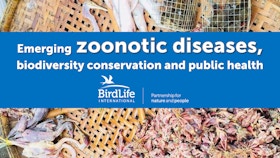Zoonotic diseases - those transferred from animals to humans - e.g. Ebola, avian influenza (or bird flu), H1N1 flu virus (or swine flu), Middle East respiratory syndrome (MERS), Rift Valley fever, sudden acute respiratory syndrome (SARS), West Nile virus, the Zika virus–and now, the novel coronavirus COVID-19.
WEBINAR, Wednesday 20th May, 4 pm
Dr Ding Li YONG, Flyways Co-ordinator, Asia, BirdLife International
This webinar will be an informative introduction on how emerging zoonotic diseases pose a major risk and threat to public health, global security and societal stability, and what we as government, business and citizens can do to mitigate the risk.
- Major outbreaks of zoonotic diseases may significantly impact and burden the local, and global economy, with consequences for human well-being, while diverting resources for other pressing developmental and conservation issues
- Many of the most significant zoonoses in Asia in recent years have their origins in mammal (SARS-Cov-, SARS-Cov-2, swine flu, Nipah virus) and bird species (avian influenza – HPAI, Japanese encephalitis)
- The risk of outbreaks (and epidemics) of zoonotic diseases is determined by the degree of contact between humans and wildlife (i.e. the human-wildlife interface)
- The poorly regulated wildlife trade in Asia has played a significant role in facilitating the emergence of zoonoses that threaten public health, the best known being SARS-Cov (2002-2003), which arose due to the trade in wild mammals in the food markets of southern China. There are considerable zoonotic risks to people involved in the hunting, butchering, sale or consumption of wild meat, with wider implications for public health.
- Habitat loss, especially of wetlands and forests is another major threat to biodiversity, and that is directly linked to the emergence of zoonotics – the loss of wetlands force wild birds to come into more frequent contact with domestic poultry – increasing the risk of cross-infection (in a multi-species ‘mixing bowl’) – some past outbreaks of avian influenza (and other bacterial zoonosis) has arisen this way – people are farming poultr (e.g. China, Vietnam) in close proximity to wild birds – increasing risk of transmission.
- Addressing the wildlife trade and habitat loss and by extension, the emergence of zoonotic diseases, is therefore a priority step in global biodiversity conservation, and is well-aligned to BirdLife’s broader strategic programmes on wildlife trade, forest and wetland conservation.
Sponsor/exhibitor contact
Sue Mulhall
[javascript protected email address]
Publish your content with EB Premium
It's not about how many you reach. It's about who. Get your news, events, jobs and thought leadership seen by those who matter to you.











